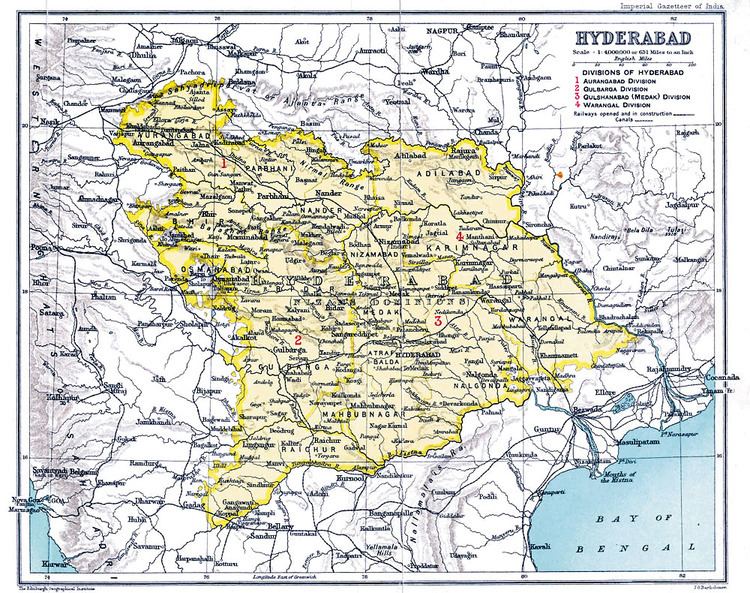Glottolog dakh1244 | ||
 | ||
Language family Indo-EuropeanIndo-IranianIndo-AryanCentral zoneUrduDakhiniDeccani Urdu | ||
Hyderabadi Urdu (Urdu: حیدرآبادی اردو) or North Dakhini is a dialect of Urdu spoken in areas of the erstwhile Hyderabad State, which corresponds to the Indian state of Telangana, and the Marathwada region of Maharashtra and Hyderabad-Karnatak region of Karnataka). It is the native language of the Hyderabadi Muslims and their diaspora. It is also known as Deccani Urdu from its former name Hyderabad Deccan. It contains loan words from Indian languages like Marathi, Telugu, Kannada and foreign languages like Arabic, Turkish and Persian. Hyderabadi Urdu is considered to be the northern dialect of the Dakhini language.
Contents
History
The Hyderabadi dialect derives from Dakhini, that took root in the Deccan when Mughal Emperor Aurangzeb invaded and occupied the region and his armies introduced the "Camp" or "Lashkari" language to the area. Lashkari was the lingua franca born in Delhi and northern India as a necessity for the armies of a succession of Muslim invaders from Muslim lands in Central Asia to communicate with the native population. The language acquired more and more Persian and Arabic words in the Mughal court of Bahadur Shah Zafar, and was used by the intelligentsia of Delhi and Lucknow. In the Deccan, however, it retained its original form, referred to now as Dakhani (of, or pertaining to, Dakhan (South), Anglosized as Deccan).
Distinctive features
Hyderabadi Urdu is mutually intelligible with most Hindi/Urdu speakers but has distinctive features from interaction with local Indian Languages such as Marathi, Telugu, Kannada.
Phonology
The letter ق (qāf) is pronounced as an unvoiced velar fricative /x/ with the same pronunciation as خ (khe) whereas in Standard Hindustani dialects the ق is pronounced as a velar plosive /k/ with the same pronunciation as ک (kāf). For example, the word 'qabar' (grave) is pronounced as 'khabar' (news).
Lexical Features
Distinct vocabulary unique to Hyderabadis:
The word اِچ "ic" is often added after a noun or verb to express the confidence of the action. In standard Urdu, ہی "hi" would be used. For example: "Biryani ich laaraun main." In standard Urdu this would be "Biryani hi laa raha hun main".
The Urdu word ہے "hai" is often dropped. For example, Urdu "Mujhey maaloom hai" would be "Mereyku maaloom"
Peculiar Features
The suffix "an" is often used to mark plurality. The letter 'n' is an almost silent nasal stop. For example, Log (people) would become Logaan, Baat (talk) would become Baataan, Aadmi (men) would become Aadmiyaan, etc. in the Hyderabadi dialect.
While talking, many long a's (as in "father") are pronounced "uh" as in "hut." For example, instead of "aadmi" (man) or "raasta" (path) in Orthodox Urdu, Hyderabadi Urdu would use "admi" and "rasta." Similarly "bhool" (to forget), "toot" (to break) and "chooriyan" (bangles) is "bhul", "tut" and "Churyan" in Hyderabadi.
Popularity and usage
Osmania University had adopted Urdu as the medium of instruction as early as 1923 which was discontinued after the fall of Hyderabad in 1948, during Indian independence. In the early sixties, film star Mehmood popularized the Hyderabadi slang in Indian films.
A very famous Guinness record holder drama /stage comedy written in Dakhni is Adrak Ke Punjey. Many Urdu poets also write in the Hyderabadi dialect, including Pagal Adilabadi, Khwamakhwa and Nukko Hyderabadi (of Chicago, Illinois).
Hyderabadi Urdu gained sudden prominence and recognition in 2006 after the success of the comedy film The Angrez that adopted the dialect. The film's success sparked several other Hyderabadi dialect films including: Kal ka nawaab, Hyderabad Nawaabs, Aadab Hyderabad, Gullu Dada, Gullu Dada returns, Berozgaar, Hungama In Dubai, Daawat-e-Ishq
Region
Administratively, Hyderabad State was made up of sixteen districts, grouped into four divisions:
